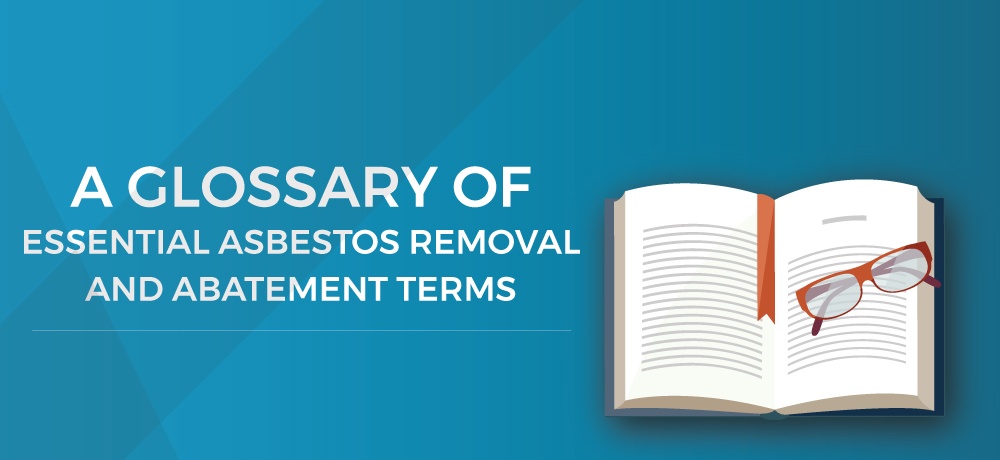A Glossary Of Essential Asbestos Removal And Abatement Terms

Every industry has its own language and terms. These words and phrases can be confusing to anyone who is not part of the daily operations of a specific industry, and the asbestos abatement business is no exception.
To help you understand the terms, acronyms, and phrases regularly used in the asbestos abatement industry, Advanced Remediation Solutions has created this handy reference guide. Here you’ll find valuable information allowing you to comprehend and communicate your asbestos removal and abatement needs effectively.
Air Monitoring.
Air monitoring is the process of measuring airborne fibre levels in a specified area over a period of time. This involves drawing a known volume of air through a filtered cassette with an effective pore size, counting the fibres that collect on the filter and expressing the result as fibres per cubic centimeter (f/cc).
DOP Testing.
Testing of equipment fitted with HEPA filters such as vacuum cleaners and negative pressure units after filter installation has been completed. An aerosol of Dioctyl Phthalate (DOP) is introduced on the upstream side of the HEPA unit, and if aerosol particles are detected on the downstream side, the unit is shut down and inspected and/or repaired. The particles generated are 0.3 micrometers in diameter or larger. The DOP test is used to determine whether there are imperfections in the filter or in the seal between the filter and the cabinet frame. Where signs of leakage in excess of 0.03 percent are detected with a photometer, the filter must be repaired or changed and equipment retested.
Containment.
Procedures took or a structure built to completely seal asbestos-containing materials behind airtight, impermeable, permanent barriers. (Usually six mil poly), and may have showers and clean and dirty rooms as well.
Decontamination Facility.
An area constructed to prevent the spread of asbestos fibres beyond the work area. It is a series of rooms consisting of a dirty room, shower room, equipment transfer area, and clean room. Decontamination facilities may be constructed for personnel leaving the work area or wastes that must be removed from the work area.
Dirty Room.
A dirty room is adjacent to the containment area where workers dispose of waste or remove personal equipment before entering the shower room.
Clean Room.
The clean room is an uncontaminated area of a decontamination facility in which workers change into their disposable clothing and back into their street clothes. It is adjacent to the shower room and opens to the outside of the decontamination facility.
Shower Room.
A shower room is part of a decontamination facility. This room is situated between the clean room and the dirty room and contains a walk-through shower.
Glove Bag.
A glove bag is a clear polyethylene plastic bag with attached long-sleeve gloves. It is designed to permit the removal of insulation on pipes and pipe fittings.
HEPA Filter — a High-Efficiency Particulate Air Filter.
HEPA filters are used in both respirators and air handling equipment. The filters have a minimum particulate removal efficiency of 99.97 percent for thermally generated mono-dispersed DOP aerosol particles with a diameter of 0.3 micrometers and a maximum pressure drop of an inch of water gauge when clean and operating at their rated airflow capacity.
Negative Air Pressure System.
Reduced air pressure within the work area compared to the ambient air pressure, produced through the use of negative air units (big fans with HEPA filters). Reduced pressure in the work area prevents leakage of contaminated air out of the work area. Airborne fibres will be trapped by the HEPA filter equipped filtration system instead.
Phase Contrast Microscopy (PCM).
PCM is a method used to determine the airborne fibre concentration in the sampled air. A segment of the sampling filter is mounted and then analyzed using a Phase Contrast Microscope at 400X to 500X magnification. Any fibres meeting the 3:1 aspect ratio that is greater than five micrometers in length are counted. These tests are taken by the environmental consultant to confirm a safe and effective abatement.
Transmission Electron Microscopy (TEM).
TEM is an analytical procedure used to determine asbestos fibre concentrations. Compared to Phase Contrast Microscopy, it has more resolving power and can be used to positively identify asbestos fibres.
Asbestosis.
Asbestosis is a fatal lung disease caused by the inhalation of high concentrations of asbestos fibres, leading to a build-up of scar tissue around the fibres. It is a chronic lung disease with symptoms that include coughing, weight loss, and difficulty in breathing.
Mesothelioma.
Mesothelioma is a type of cancer that develops from the thin layer of tissue and covers many of the internal organs (known as the mesothelium). The most common area affected is the lining of the lungs and chest wall. Mesothelioma is caused by inhaling asbestos fibers. The risk factors for developing mesothelioma include working in an asbestos plant or working with asbestos products. Smoking is not a risk factor by itself but can further the damage done by asbestos exposure.
If you’re looking for asbestos and mold removal experts in Edmonton, AB, reach out to Advanced Remediation Solutions. We specialize in removing mold, asbestos, and other hazardous contaminants from residential and commercial buildings. With over fifteen years of experience, we can determine the best course of action for your specific site and situation.
To learn more about how we can help you, please click here. If you have any questions about asbestos abetment and mold remediation or for free estimates, please get in touch with us here.